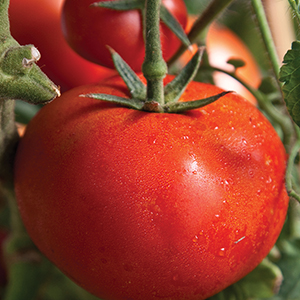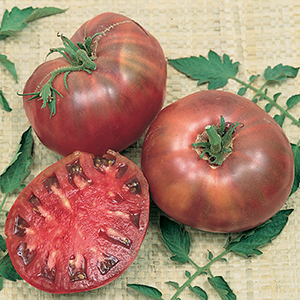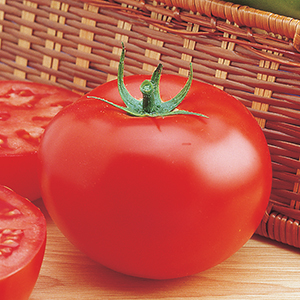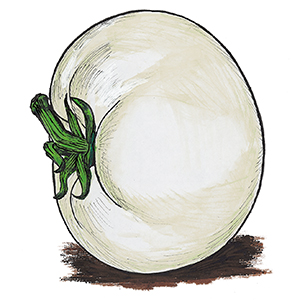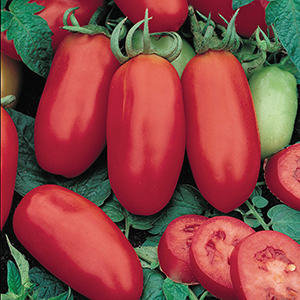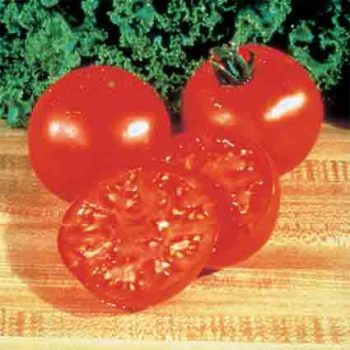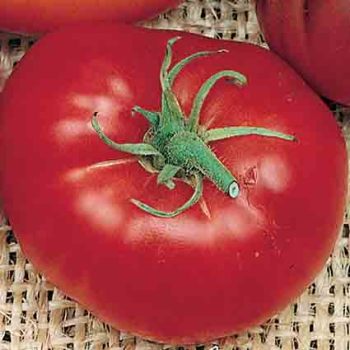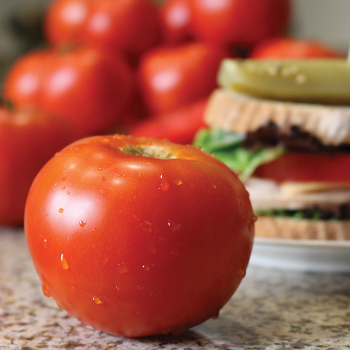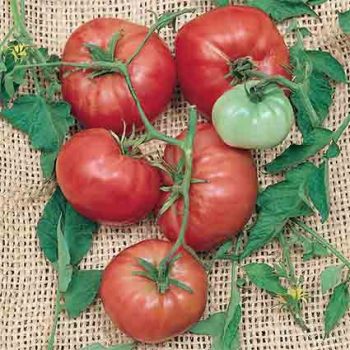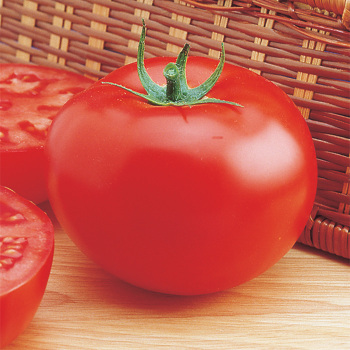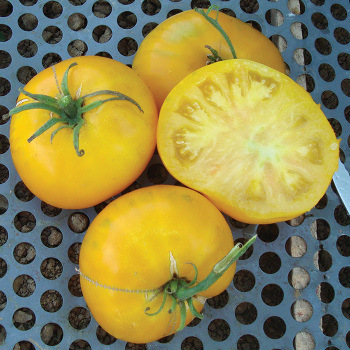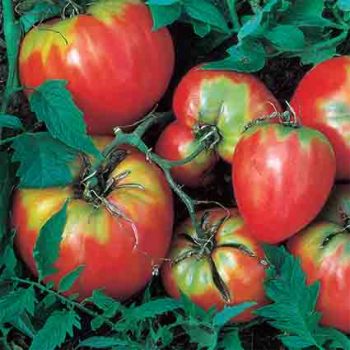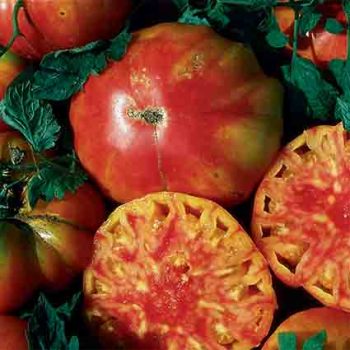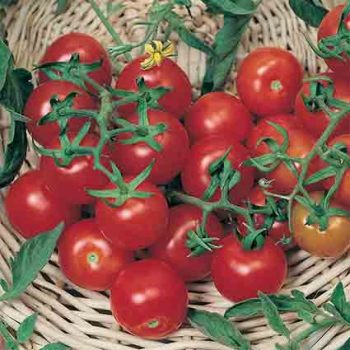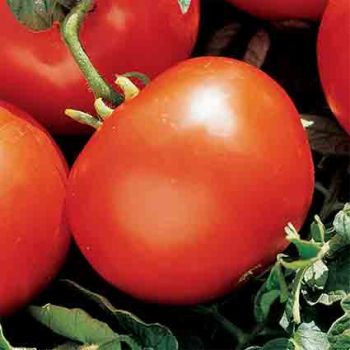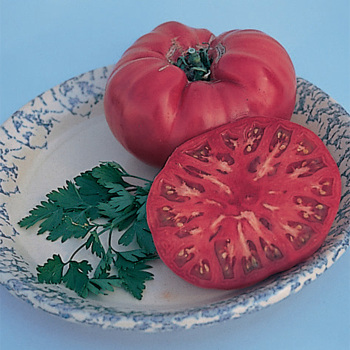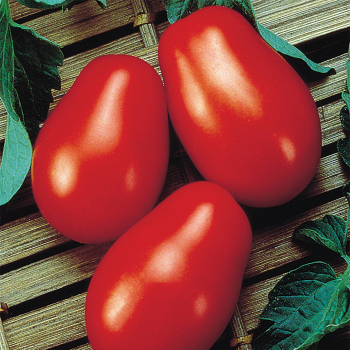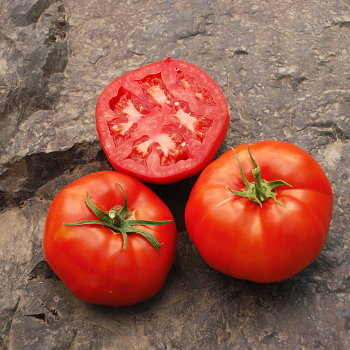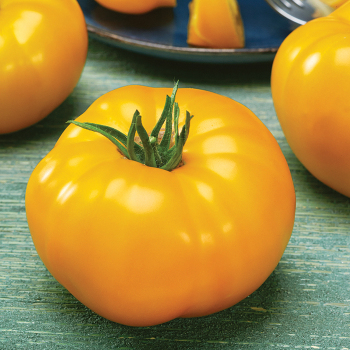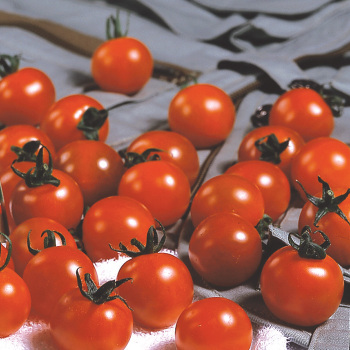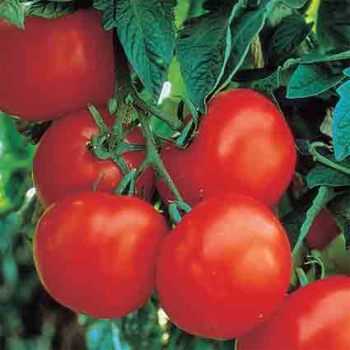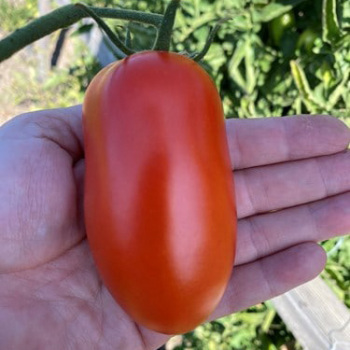Sow in flats or cell-packs 6 to 8 weeks prior to transplanting outdoors. Tomato seed will not germinate in cool soil. To enhance germination soak seeds for 8 hrs. starting with warm water prior to sowing. Once sown, place trays or packs on a heat mat with consistent bottom heat of 75°-85°F. Plant seeds 1/4 inch deep. When plants are about 1 1/2 inches tall with two sets of true leaves, transplant into Jiffy® Peat Pots. After threat of frost, harden off tomato plants for 7-10 days, then transplant outdoors 3 to 4 feet apart when nighttime temperatures stay above 45°F. Maturity days given are from date of outdoor transplanting.
Tomatoes can be attacked by a range of diseases and insects, so monitor plants for symptoms throughout the growing season.
To combat diseases, you can grow varieties bred with resistance to common disease problems. With the help of your local extension service, determine what diseases are common in your area. Look for varieties with codes indicating resistance to those diseases. The disease resistance codes appear at the beginning of each variety description. If no codes are given, as with many heirlooms, that means they don't have bred-in disease resistance. Even resistant varieties may need some preventative fungicide applications, especially in wet, humid seasons when disease pressure is highest.
Common Tomato Disease Codes
V = Verticillium Wilt
F = Fusarium Wilt (FF = Races 1 & 2 and FFF = Races 1, 2 & 3)
N = Nematodes
T = Tobacco Mosaic Virus
A = Alternaria Stem Canker
St = Stemphylium Gray Leaf Spot
LB = Late Blight
-
#S00014* 20 seeds - $3.55 - In Stock
Beautiful dark red fruits are sweet, solid and meaty. Smooth, crack resistant, large fruits ripen all the way...Buy Now Details -
#S00029* 30 seeds - $3.95 - In Stock
* Garden Ready Plants - $8.50 - In Stock
Real tomato taste in a turn of-the-century Amish heirloom. One of the best for sauces and canning. Bright red fruits...Buy Now Details -
#S00074* 15 seeds - $4.95 - In Stock
* Garden Ready Plants - $8.50 - In Stock
(VFA FOR GLS ToMV) Bright red, unbelievably juicy fruits weigh up to 1 lb. and have a higher Brix of 6.6. PLUS it has...Buy Now Details -
#S00080* 15 seeds - $5.35 - In Stock
(VFFA FOR GLS ToMV ToTv) With the added crimson gene this beauty is visibly deeper red inside and out. Fruits are...Buy Now Details -
#S00128* 30 seeds - $5.75 - In Stock
(A) Big, crack-free fruits combined with exceptional flavor to make this one of America's favorite varieties. Fruits...Buy Now Details -
#S00087* 15 seeds - $3.95 - In Stock
* Garden Ready Plants - $8.50 - In Stock
This huge, prize winning champion is a cross between two heirlooms bred by Minnie Zaccaria. Fruits repeatedly tip the...Buy Now Details -
#S00103* 30 seeds - $3.85 - In Stock
* 1/32 Ounce - $7.95 - In Stock
80 Days Prolific yielder, with an old-fashioned flavor you'll remember fondly from childhood. A multi-use old-timer...Buy Now Details -
#S00112* 30 seeds - $3.95 - In Stock
* Garden Ready Plants - $8.50 - In Stock
Heirloom Amish varieties that date back to 1885 and are generally considered to be the world's best-flavored...Buy Now Details -
#S00105* 30 seeds - $3.95 - In Stock
Heirloom Amish varieties that date back to 1885 and are generally considered to be the world's best-flavored...Buy Now Details -
#S00149* 20 seeds - $5.25 - In Stock
(VFFNTA) Delivers every desirable quality in a compact, patio-type variety: extreme earliness and huge yields of...Buy Now Details -
#S00195* 15 seeds - $5.35 - In Stock
(VFFA GLS ToMV) Large, smooth, 8 oz. fruits have an outstanding, sweet flavor. PLUS it has intermediate resistance to...Buy Now Details -
#S00188* 30 seeds - $3.95 - In Stock
A reliable producer of unusual, medium pink-purple fruits that appear brown in color, and average 8 to 12 oz.,...Buy Now Details -
#S00380* 30 seeds - $3.95 - In Stock
Our only climbing type produces enormous yields. Vine grows 10 to 15 ft. tall and should be supported on a trellis....Buy Now Details -
#S00131* 30 seeds - $3.95 - In Stock
* Garden Ready Plants - $8.50 - In Stock
An excellent slicer, most fruits over 1 lb., with many 2 to 3 lbs., and a long time world record holder at 7¾...Buy Now Details -
#S00240* 30 seeds - $6.95 - In Stock
(VFF) A popular variety that continues to bear until frost. Plants produce heavy crops of 4 to 5 oz. fruits,...Buy Now Details -
#S00297* 30 Seeds - $2.45 - In Stock
An attractive, tasty beefsteak-type with true yellow to pale orange skin and yellow flesh. Fruits weigh 6 to 7 oz....Buy Now Details -
#S00300* 30 seeds - $3.85 - In Stock
Uniquely shaped pink type resembles a heart. Rosy-pink, smooth fruits weigh 12 oz. to 2 lbs. Flesh is firm, with few...Buy Now Details -
#S00001* 30 seeds - $5.35 - In Stock
(VFFTA GLS ToMV) (Variety Pio) The best hybrid on the market today. Smooth, bright red, deep oblate fruits, 10 to 15...Buy Now Details -
#S00347* 30 seeds - $3.85 - In Stock
An ancient heirloom from the hills of West Virginia. Huge, mild-flavored, beefsteak-type fruits weigh up to 2 lbs....Buy Now Details -
#S00424* 50 seeds - $3.55 - In Stock
The standard salad type with fruits somewhat larger than other cherry types. Tall growing plants produce a big yield...Buy Now Details -
#S00450* 50 seeds - $3.75 - In Stock
Perhaps the most beautiful tomato of all, a perfect globe shape with a pleasant sweet flavor. Produces high yields of...Buy Now Details -
#S00481* 30 seeds - $3.95 - In Stock
Garden Ready Plants - $8.50 - In Stock
Said to have prevented bankruptcy. In the 1930's, a guy nicknamed Radiator Charlie was in tough financial shape. He...Buy Now Details -
#S00519* 30 seeds - $3.95 - In Stock
An old heirloom originally grown by the Mennonite community of Virginia and one of the best ever for slicing. Fruits...Buy Now Details -
#S00009* 30 seeds - $4.25 - In Stock
(FNA) Has the vigor, disease resistance, and fruit-setting ability of a hybrid combined with the huge size and flavor...Buy Now Details -
#S00618* 50 seeds - $3.65 - In Stock
* 1/2 ounce - $17.95 - In Stock
Roma is considered to be the most well-known paste-type tomato, perfect for sauces, pastes and ketchup. Its heavy...Buy Now Details -
#S00624* 30 seeds - $3.65 - In Stock
One of the best all-purpose varieties. Ideal for canning. Ripens evenly from the inside out. Excellent flavor - rich,...Buy Now Details -
#S0062730 Seeds - $4.25 - In Stock
An improved version of perhaps the most well known tomato in the U.S., reintroduced by Rutgers University for their...Buy Now Details -
#S0067130 Seeds - $4.05 - In Stock
Very attractive, large, 3 in., blemish-free, beefsteak-type tomatoes can grow up to 1 lb. each! Juicy fruits are...Buy Now Details -
#S00747* 30 seeds - $5.75 - In Stock
(F ToMV) Eat 'em like candy. Super sweet cherry variety that grows in long trusses of 1 to 1½ in., bright red...Buy Now Details -
#S00785* 20 seeds - $3.95 - In Stock
(VF) Possibly the best early season-opening tomato in the world. Bred by Dr. Paul Thomas, the famous breeder of...Buy Now Details -
#S00818* 30 seeds - $2.45 - In Stock
Allergic to the pigment in red tomatoes? Skin and flesh are a creamy white, free of usual acids. Fruits weigh about 5...Buy Now Details -
#S00849* 10 Seeds - $5.45 - In Stock
(VFF ToMV) AAS Regional Winner (Great Lakes, Heartland). An impressive early maturing, high yielding, highly disease...Buy Now Details





